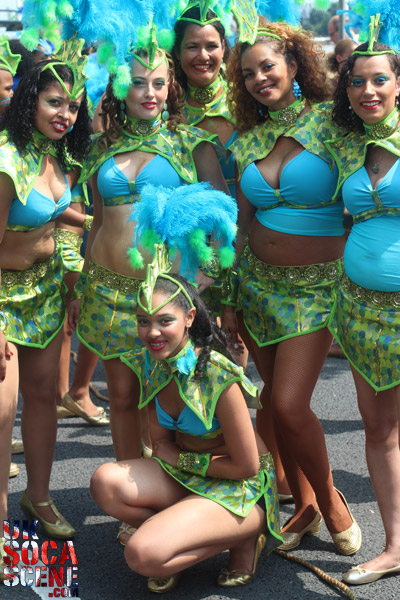Soca in Europe
Ah ready from since ah born.
Look how the sun now raising up and the crowd now waking up
the atmosphere have vybz
and nuttin’ cyah break it up
the gyal dem ah wine non stop
we ha de drinks dem inna my cup……
Bunji Garlin – Differentology 2013
Soca Family, its Monday already! The week has started again and time is moving so that means its pace. Doh study the European weather, where Soca is playing the sun is always shining. Now who all aboard the next stop….Berlin mih hear yuh say…
Inna Europe we party all nite, all year
multiple parties and countries we hit inna row
Friday, Carnival Fever 2013 was the very last show
before we head out on the road again
the gyal dem ah release de love
so lemme see yuh hands up
It’s something about this music…..
Arguably the most well-known music originating from the island of Trinidad & Tobago, the infectious ever evolving upbeat rhythm, emphasised by the fast tempo beats is the drumbeat of the Caribbean. Defining the scene, accompanying carnivals around, raising the temperature gauge and energies of party people and masqueraders and paving the way for cross marketing opportunities, soca music has and continues to leave its mark sporadically on the international stage.
 Having since long been the dominant musical force behind Caribbean culture and themed festivals, the artform was inspired by Calypso. In the 70’s the rhythmical fusion was created by the father of soca, Lord Shorty aka “Ras Shorty”, from Trinidad & Tobago, when he experimented with the calypso beat infusing it with the local chutney. With soca hits such as ‘Cloak and Dagger’ and albums such as ‘Endless Vibrations’ and Sweet Music’ to name a few, soca music became popular amongst the second generation, following a gathering from his revolutionised songs. Over the years, this infectious rhythmical beat evolved into the definitive indigenous musical art form of the Caribbean with each island adding to its essence. Whilst argument could be heard on the seasonality aspect of the music, controversy surrounding the commercialisation of the artform and poor delivery of lyrics, the question is, has soca music been internationally recognised and further more is the light beckoning the music genre to the centre stage brightening with hope?
Having since long been the dominant musical force behind Caribbean culture and themed festivals, the artform was inspired by Calypso. In the 70’s the rhythmical fusion was created by the father of soca, Lord Shorty aka “Ras Shorty”, from Trinidad & Tobago, when he experimented with the calypso beat infusing it with the local chutney. With soca hits such as ‘Cloak and Dagger’ and albums such as ‘Endless Vibrations’ and Sweet Music’ to name a few, soca music became popular amongst the second generation, following a gathering from his revolutionised songs. Over the years, this infectious rhythmical beat evolved into the definitive indigenous musical art form of the Caribbean with each island adding to its essence. Whilst argument could be heard on the seasonality aspect of the music, controversy surrounding the commercialisation of the artform and poor delivery of lyrics, the question is, has soca music been internationally recognised and further more is the light beckoning the music genre to the centre stage brightening with hope?
 Flying the flag internationally high the song ‘Hot, Hot, Hot’ became the biggest selling soca hit of all time in 1982 until now, after it was first recorded with Trinidad & Tobago arranger Leston Paul. From the island of Montserrat, the late soca king Mighty Arrow made a mark on the scene by peaking at number #59 on the UK singles chart, gaining worldwide recognition and global acclaim. American artist Buster Point Dexter re-recorded the song years later, at which time it became an international hit. In 1983 the song was the unofficial road march song at Europe’s biggest street party – Notting Hill Carnival and in 1984 became the official song for the World Cup football in Mexico. The single was re-released and sung in 20 languages and continues to sell millions of copies globally. His songs featured on other albums and continue to be endorsed commercially by advertising firms and featured on major motion picture soundtracks.
Flying the flag internationally high the song ‘Hot, Hot, Hot’ became the biggest selling soca hit of all time in 1982 until now, after it was first recorded with Trinidad & Tobago arranger Leston Paul. From the island of Montserrat, the late soca king Mighty Arrow made a mark on the scene by peaking at number #59 on the UK singles chart, gaining worldwide recognition and global acclaim. American artist Buster Point Dexter re-recorded the song years later, at which time it became an international hit. In 1983 the song was the unofficial road march song at Europe’s biggest street party – Notting Hill Carnival and in 1984 became the official song for the World Cup football in Mexico. The single was re-released and sung in 20 languages and continues to sell millions of copies globally. His songs featured on other albums and continue to be endorsed commercially by advertising firms and featured on major motion picture soundtracks.
 The main attraction with soca lies mainly with the upbeat rhythm. ‘Who let the dogs out’ was a single originally written by Anslem Douglas for Trinidad & Tobago carnival in 1998. In 2000 an English band, Baha Men playing a modernised style of Bahamian music called Junkanoo, released a remake of ‘Who let the dogs out’ and placed it in the movie soundtrack Rugrats in Paris: The movie. It reached number #2 in the UK singles chart, becoming the 4th biggest selling single in UK, earning several awards, amongst them a Grammy Award and Billboard Music Award.
The main attraction with soca lies mainly with the upbeat rhythm. ‘Who let the dogs out’ was a single originally written by Anslem Douglas for Trinidad & Tobago carnival in 1998. In 2000 an English band, Baha Men playing a modernised style of Bahamian music called Junkanoo, released a remake of ‘Who let the dogs out’ and placed it in the movie soundtrack Rugrats in Paris: The movie. It reached number #2 in the UK singles chart, becoming the 4th biggest selling single in UK, earning several awards, amongst them a Grammy Award and Billboard Music Award.
‘Tempted to touch’ was the international hit, produced by Barbadian artist, Rupee under Atlantic Record Label in the UK and listed for 49 weeks under 5 different charts where it peaked number #31 on the Sweden Singles top 60. There have been other artists such as Kevin Lyttle from St Vincent & The Grenadines and Jamsey P who have been able to spread soca music on the international scene. Burning the international charts, in 2004, ‘Turn Me On’, was a major hit on the European circuit reaching at number #2 on the UK chart and getting covered by local urban artist’s such as Jay Sean.
 Born in London, the Queen of Soca Alison Hinds grew up in Plaistow East London, but fell quickly in love with Barbados. In 2007, ‘Roll it Gal’, became the number 1 empowerment international song for women where it also shot to the top of the charts. In the same year, a reworked version of the song entitled ‘Roll It’ written by Rihanna and performed by J-Status featuring Shontelle was released in several European countries.
Born in London, the Queen of Soca Alison Hinds grew up in Plaistow East London, but fell quickly in love with Barbados. In 2007, ‘Roll it Gal’, became the number 1 empowerment international song for women where it also shot to the top of the charts. In the same year, a reworked version of the song entitled ‘Roll It’ written by Rihanna and performed by J-Status featuring Shontelle was released in several European countries.
It is well known that soca music is fast paced with lyrical content that a few can understand or can afford to at times bypass the ‘somewhat’ questionable lyrical delivery focusing instead on the beat. Often, at times individuals are attracted to the music because of the rhythm, the intoxicating culture and the hypnotic sense that comes with. However in looking at the bigger scope and potential is this enough to keep this style of art form on the international charts and possibly one day feature on the international concerts alongside A-listers?
To d future…
http://www.youtube.com/watch?v=zxu99N1Cj2I
Who says the future is quite possibly not in Europe?
He might have balked at the idea that soca music had a future way back in 2011, but in the echoing past footsteps of his success with songs such as ‘Soul on Fire’, KMC might as well have spoken a wee bit too soon without waiting for time to reveal its true course. In 2006, at the height of the World Cup, Maximus Dan’s ‘Soca Warriors’ was the biggest song in Europe. Reverberating with kindred spirits all around and internationally, Maximus Dan was quoted as having said on TriniJungleJuice, “I wanted to have a song to sing to infinity … til God come. I didn’t want it to just be a football song”. It is said that spurred on by the fighting spirit, an increase in the number of soca radio stations and collaborations emerged all around Europe in the wake of the song and the success had by the SOCA Warriors Soccer Team and still continues till now.
It is a well-known fact that the Viking of Soca, otherwise known as Bunji Garlin is a regular visitor to the European shores alongside his wife and artist Fay Ann Lyons flying the flag high for soca music and bringing it to places it has never been heard before. In 2007 approached with a joint deal with VP, Bunji Garlin toured Munich, Hamburg, Stockholm and Sweden. In the following years he has toured various cities such as Venice, London and Berlin to name a few where he also appeared at Berlin Carnival in 2012. With some of his tracks such as ‘Free Up the Vibes’ and ‘Long Time’ produced by popular Swedish producer Million Style, it is now wonder that in 2013, Europe has been and will be waiting with abated breath for his and Fay Ann’s Lyons arrival and presence on the scene.
There is a strong and vibrant market in Europe for Soca music that has been pushed by avid lovers and appreciators of soca music and Caribbean culture. The million pound or euro millions question remaining is; Does soca music in its current state and industry have the potential to one day break the moulds, feature on the international charts, awards and concerts alongside A-listers and peak endlessly in the global charts?
Answer: Through unity, acceptance of the revolving artform, appreciation for its musical history and lineage, strategic planing and marketing it has the possibility, time will only tell…however that is my view. What is yours?
As always UKSS is interested to hear your view & thoughts…Share what you have in mind below the comments section and let’s spark a debate…..












Comments
No comment yet.